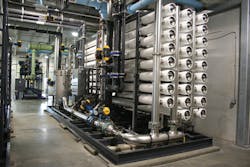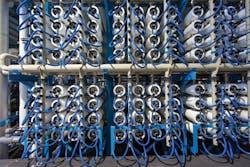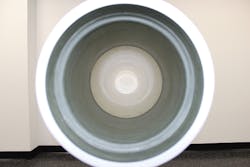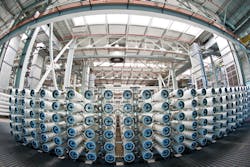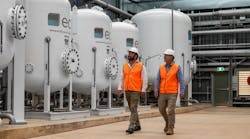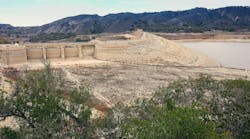By Richard Chmielewski
When one imagines a reverse osmosis (RO) system, the picture in the mind’s eye is that of the long, horizontal, usually white pressure vessels. While you cannot see the RO membrane located inside, its housing is instantly recognizable.
A typical RO system.
Today, most RO membranes are housed in fiberglass reinforced (FRP) pressure vessels, specifically manufactured to contain the membranes and withstand the high pressures required by today’s RO membranes. These are not simply plastic pipes but rigorously designed and manufactured pressure vessels.
FRP pressure vessels are produced from spools of fiberglass fiber and held together by a specific grade of epoxy resin that is cured at elevated temperatures. The manufacturing process is computer controlled with each strand of glass fiber placed at a specific location and orientation to achieve optimum strength. The glass fiber and resin mixture is wound around a precision-machined mandrill, which accounts for the perfectly circular, defect free interior of today’s RO vessels. The vessels are often painted white to reduce light transmission through the vessel to minimize growth of algae and other biological concerns.
RO pressure vessels at the Carlsbad Desalination Plant provided by Protec-Arisawa America. Most of the vessels have design pressure of 1,200 psi.
These are often designed, manufactured and tested to stringent ASME Boiler and Pressure Vessel Code requirements, which has a specific section for FRP pressure vessels, Section X. It requires each manufacturer to qualify a vessel by first performing a 100,000 cycle hydrostatic test going from zero to design pressure, all done at an elevated temperature of 150°F (above the operating limits of all current RO membranes). Subsequent destructive testing subjects the vessel to increasing pressure until failure.
To qualify for the ASME code plate, the vessel must not leak during the cycle test and must successfully achieve a safety factor six times (6X) the vessel’s design pressure. In addition, each of the critical raw materials must be identified and the method of production documented. Each facility that applies the ASME code plate undergoes an audit by ASME every five years. Each step in the design, production and testing of the vessels is reviewed by the ASME audit committee.
A display vessel designed with ‘Made in America’ flag.
The Carlsbad Desalination Facility, for example, is the largest desalination RO system in the western hemisphere. It contains more than 2,200 RO pressure vessels with design pressure of 1,200 psi. These vessels were qualified under ASME’s Section X and operated above 7,200 psi before failure. Vessels manufactured with the ASME code plate all have gone through this rigorous qualification testing and each vessel is hydrostatically tested before the code plate is applied.
Today’s RO vessels are available in a range of pressure ratings depending on the membranes being used and the type of water being treated. Sea water has high osmotic pressure (~400 psi), meaning that high operating pressures are required to overcome the osmotic pressures developed in the concentrate stream. Other common pressure ratings are 300, 450, 600 and 1,000 psi. Newly developed higher pressure ratings (up to 1,800 psi) are now available.
Interior view of RO vessel.
Owners of RO systems should understand the important safety implications implied by the ASME code. Owners and their engineers should insist on vessels that are designed, manufactured and tested in accordance with ASME Section X. Generally, there is a nominal fee to obtain the ASME Section X code plate, which is affixed to the vessel once manufacturing and testing are complete.
In our current global economy, RO vessels are available from foreign suppliers, some with ASME code certification and many without. Protec Arisawa America manufactures RO pressure vessels complying with the stringent ASME Section X requirements in its Vista, Calif., location as well as in Mungia, Spain, and in Japan.
Some of the 3,150 RO vessels at the Orange County Ground Water Replenishment System, with 300 psi design pressure vessels.
The next time you see an RO system, know that extensive engineering has gone into the design and production of the pressure vessels that have become the face of the RO industry.
About the Author: Richard Chmielewski is product manager for Protec Arisawa, a leading manufacturer of RO pressure vessels. He is responsible for vessel sales and marketing and is involved in new product development efforts. He has a 40-year history in the membrane business, including working for consulting engineers, membrane manufacturers and as project manager for a large international water treatment equipment manufacturer. Chmielewski was also involved with the introduction of hollow fiber membrane technology into the U.S., having sold the first drinking water system using microfiltration (MF) membranes in the state of California.
